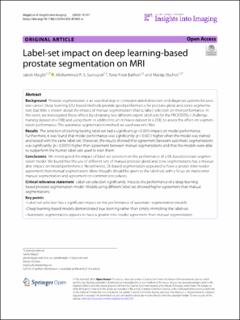| dc.contributor.author | Meglic, Jakob | |
| dc.contributor.author | Sunoqrot, Mohammed R. S. | |
| dc.contributor.author | Bathen, Tone Frost | |
| dc.contributor.author | Elschot, Mattijs | |
| dc.date.accessioned | 2024-01-17T12:20:15Z | |
| dc.date.available | 2024-01-17T12:20:15Z | |
| dc.date.created | 2023-09-26T09:25:04Z | |
| dc.date.issued | 2023 | |
| dc.identifier.citation | Insight into Imaging. 2023, 14 (1) | en_US |
| dc.identifier.issn | 1869-4101 | |
| dc.identifier.uri | https://hdl.handle.net/11250/3112160 | |
| dc.description.abstract | Background
Prostate segmentation is an essential step in computer-aided detection and diagnosis systems for prostate cancer. Deep learning (DL)-based methods provide good performance for prostate gland and zones segmentation, but little is known about the impact of manual segmentation (that is, label) selection on their performance. In this work, we investigated these effects by obtaining two different expert label-sets for the PROSTATEx I challenge training dataset (n = 198) and using them, in addition to an in-house dataset (n = 233), to assess the effect on segmentation performance. The automatic segmentation method we used was nnU-Net.
Results
The selection of training/testing label-set had a significant (p < 0.001) impact on model performance. Furthermore, it was found that model performance was significantly (p < 0.001) higher when the model was trained and tested with the same label-set. Moreover, the results showed that agreement between automatic segmentations was significantly (p < 0.0001) higher than agreement between manual segmentations and that the models were able to outperform the human label-sets used to train them.
Conclusions
We investigated the impact of label-set selection on the performance of a DL-based prostate segmentation model. We found that the use of different sets of manual prostate gland and zone segmentations has a measurable impact on model performance. Nevertheless, DL-based segmentation appeared to have a greater inter-reader agreement than manual segmentation. More thought should be given to the label-set, with a focus on multicenter manual segmentation and agreement on common procedures. | en_US |
| dc.language.iso | eng | en_US |
| dc.publisher | Springer Nature Ltd. | en_US |
| dc.rights | Navngivelse 4.0 Internasjonal | * |
| dc.rights.uri | http://creativecommons.org/licenses/by/4.0/deed.no | * |
| dc.title | Label-set impact on deep learning-based prostate segmentation on MRI | en_US |
| dc.title.alternative | Label-set impact on deep learning-based prostate segmentation on MRI | en_US |
| dc.type | Peer reviewed | en_US |
| dc.type | Journal article | en_US |
| dc.description.version | publishedVersion | en_US |
| dc.source.volume | 14 | en_US |
| dc.source.journal | Insight into Imaging | en_US |
| dc.identifier.doi | 10.1186/s13244-023-01502-w | |
| dc.identifier.cristin | 2178804 | |
| dc.relation.project | Norges forskningsråd: 295013 | en_US |
| dc.relation.project | Kreftforeningen: 215951 | en_US |
| dc.relation.project | Samarbeidsorganet mellom Helse Midt-Norge og NTNU: 90265300 | en_US |
| dc.relation.project | Samarbeidsorganet mellom Helse Midt-Norge og NTNU: 982992100 | en_US |
| dc.source.articlenumber | 157 | en_US |
| cristin.ispublished | true | |
| cristin.fulltext | original | |
| cristin.qualitycode | 1 | |

